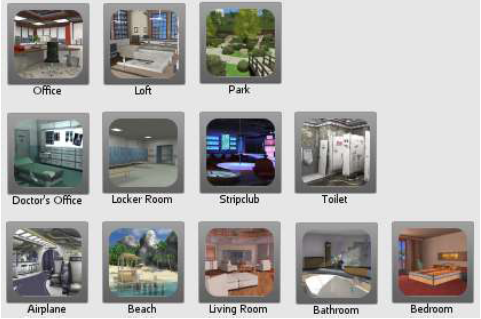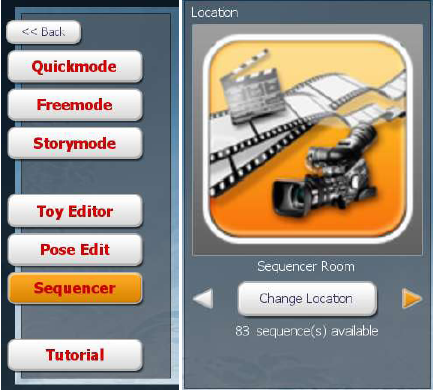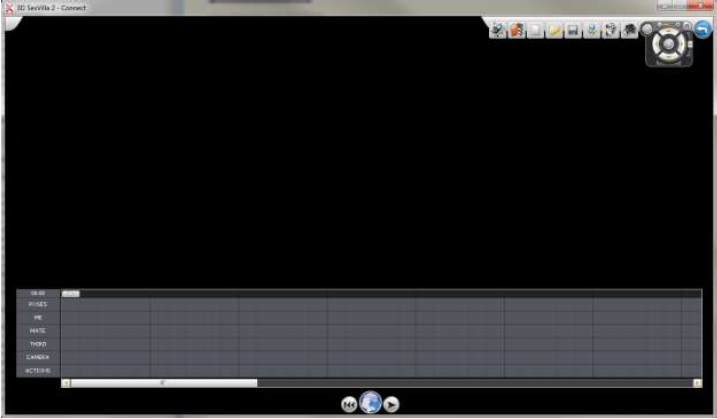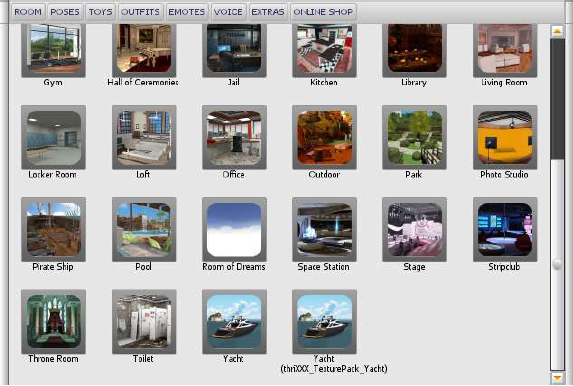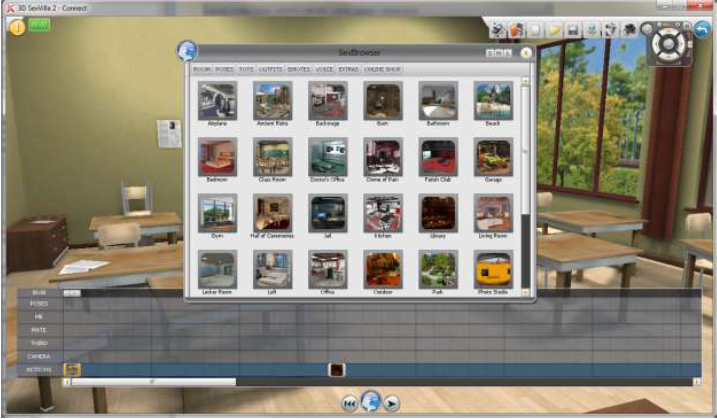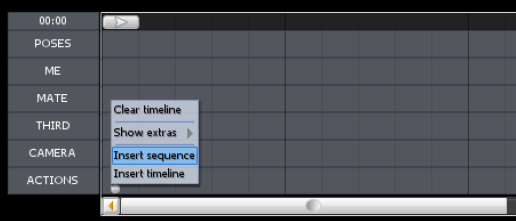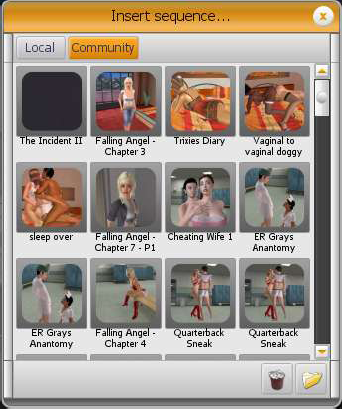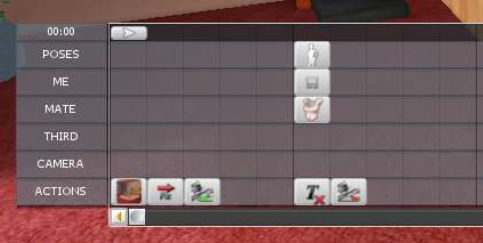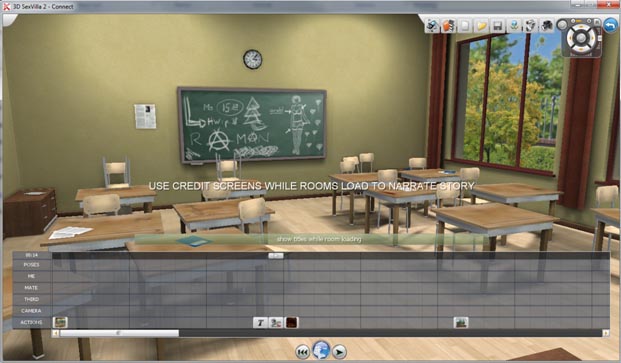The Sequencer Room - CP
The 'Sequencer Room' is a special feature that allows the linking of multiple rooms and sequences into one sequence allowing for more complex story telling.
For example, a sequence can now take place over a couple of locations and reduces the need for multi-part serialized content that is typically posted as Part 1, Part 2, Part 3 etc.
Linking together a couple of rooms as illustrated and described conceptually below must allow for load times for geometry and textures when placed in the timeline. That requirement is described in more detail later on this page.
Multi-room sequencing and scripting will allow for stories development like the following examples to be created.
- After a hard day at the office, your advances at the hot secretaries having been rebuffed, you frustratingly head back to you loft apartment near City park. You decide to go for a walk and by chance befriend a nice understanding girl, end up having some great public sex under a tree, and have a fantastic end to a frustrating day at 'The Office'.
- You're a doctor and after a day of doing 'gyno' examinations at the clinic your all worked up, you go to the locker room to get ready to leave & hook up with a buddy, decide to go to the strip club and end up fucking one of the strippers in the john.
- You take your jet to your private island, end up in your condo with a date, and then have multi-room sex in the bathroom and bedroom.
As you can see, a variety of locations allows for a more exciting fantasy story! However, this is a complex feature and there are some technical limitations which are described below.
How To Use
NOTE: You must have the sequencer option installed to access the menus illustrated below.
To use this ability you must access this area thru the 'New Scene' button Then go to → 'Sequencer' button, Then select the → Sequencer Room in the Change Location selections area.
Use the left and right arrows to select the location.
Select the orange icon with director's slate and video camera which indicates 'Room Sequencer' is selected and ready to launch.
Click  to activate the Sequencer Room option
to activate the Sequencer Room option
Once you have entered the Sequencer Room you can create an new multi sequence and/or link existing sequences of your own as well community shared ones from Gamerotica.
NOTE: You cannot access this option from within other rooms or scenes, functionality is only available in the 'Sequencer Room' while active.
The Timeline
When you first enter the Sequencer Room you will be presented with a blank timeline.
To build up a multi-room timeline sequence from scratch, click the blue globe in the 'Sex Browser'.
A dialog box will pop up with the 'ROOMS' option listed on the top left hand corner of the dialog box.
Please note this 'ROOMS' button is only available on this dialog box when in the 'SEQUENCER ROOM' is active and will not appear in the Sex Browser as a selectable option in any other room.
Once the Room button is selected a list of available rooms is presented.
NOTE: This will show only rooms that you currently have installed.
If ALL Sex Pack updates have not installed all room as illustrated in this screen shot may not be present.
From the selections available drag the first room you want to appear into the first column at 00:00 to the start of the ACTIONS row. To add another room drag and drop it further down the time line as illustrated below.
Special Considerations
IMPORTANT: It takes a few seconds for a rooms geometry and textures to load when playing back a multi room sequence when a room change is to occur.
Different room also have different load time based on the complexity of the geometry and the number of textures.
Rooms like the bedroom and living room, which are relatively simple shapes with limited textures can load in 3-5 seconds, while rooms like the library and strip club, that have many areas and a lot more detail and textures can take 7+ seconds to load .
TIP: Try to anticipate the 'geo' load times in your sequence and leave enough space between ACTIONS to allow this loading process to complete entirely before moving on in the timeline.
If scene changes are placed too close together in the ACTIONS row of the timeline (like every 2 seconds in this example), they may not have enough time to load as anticipated. For example, if the first room takes 4 seconds to load and the second instance of a room is timed to load 2 seconds later, it will be skipped and the next room at the 4 second mark will be loaded right after the time it took to load the first room. The second room that was suppose to load at 2 seconds never has a chance due to the first item still being loaded and using system resources to complete that task. Adjust your timing between room changes and sequence to account for this.
TIP: A good way to gauge 'minimum' spacing for load times is to count the seconds it takes to load the room initially when it is first dragged into the timeline and is completed displaying an appears on-screen. If the room takes 6 seconds leave 7-8 seconds to the next room to allow for processing of all geometry,texture loading and other memory intensive tasks.
In addition, scene geometry and related textures can take up a lot of memory when played back. The number of rooms practical in a sequence will also be impacted by what else is going on in the scene in regards to the number of EXTRAS. If there are a lot of poses, outfits, etc. included in a scene these also ad up and contribute to load times and a heavy scene payload to be processed.
Very complex scenes will thus be limited in playback by overall PC system performance in regards to system RAM and GPU capabilities, so a feature length movie is not really practical for one multi-room scene with all related scripting included. NOTE: If scenes become overly complex with large memory footprints systems may slow down and impact other programs and may even cause system out of memory errors.
Once you have the rooms you want to be used in a sequence they can be saved like normal sequences and will appear in your Save Slots. Editing the actions in a sequence is then the same process and authoring techniques as applies for a single room sequence making.
Inserting Existing Seqeunces
Another technique for building multi-room timeline sequences is using existing local sequences and/or using shared community sequences.
To insert existing sequences is similar to the from scratch method and use the ACTIONS row on the timeline.
Click on the ACTIONS timeline at the time slot location to insert an existing sequence. A pop-up menu will appear → Select 'Insert sequence'.
This command will open up a dialog box with Local and Community saved sequences, and searche your hard drive for previously saved and installed versions, providing them in the list to choose from. Double click on the desired sequence and it will load into the timeline.
The sequence will load and look something like the following.
CAUTION: If sequences are inserted and loaded from other than in the Room Sequencer timeline itself the loading of the a sequence can overwrite the current sequence.
For example, going to the load dialog box via the folder method in the menus top right corner can overwrite current work and not append the script properly.
As usual saving often when working on complex sequences is advised.
As well, saving versions with different names as you are developing your sequence is a good practice. (E.g. office_01, office_02, etc) In case a file goes of the rails and becomes corrupted you can roll back to a previous effort and not lose your valuable work, or at least have a recovery position in case of catastrophic error.
Using Text During Load Times
TIP: While rooms are loading you can use the text and credit title EXTRAS to provide on screen information to further narrate the scene and augment your storytelling.
This technique is often better than having the viewer wait for the next scene to load.
Place a text extra in front of the room icon in the ACTIONS row just before the change.
Adding narration, comments or any other text to further the story and entertain viewers while scene changes load is a good way to keep the viewer engaged.
Multi Room functionality for storytelling opens up many new options ENJOY!
